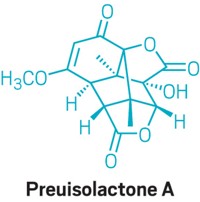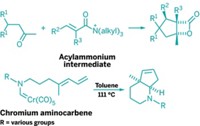Advertisement
Grab your lab coat. Let's get started
Welcome!
Welcome!
Create an account below to get 6 C&EN articles per month, receive newsletters and more - all free.
It seems this is your first time logging in online. Please enter the following information to continue.
As an ACS member you automatically get access to this site. All we need is few more details to create your reading experience.
Not you? Sign in with a different account.
Not you? Sign in with a different account.
ERROR 1
ERROR 1
ERROR 2
ERROR 2
ERROR 2
ERROR 2
ERROR 2
Password and Confirm password must match.
If you have an ACS member number, please enter it here so we can link this account to your membership. (optional)
ERROR 2
ACS values your privacy. By submitting your information, you are gaining access to C&EN and subscribing to our weekly newsletter. We use the information you provide to make your reading experience better, and we will never sell your data to third party members.
Synthesis
Getting To The Core In One Step
Drug Discovery: Single-step annulation could ease access to key natural-product analogs
by Stu Borman
August 4, 2014
| A version of this story appeared in
Volume 92, Issue 31
A family of natural products called polyprenylated acylphloroglucinols (PPAPs) may not have a euphonious name, but they have been found to have promising biological effects, including anticancer and antidepressant properties. The drug discovery community would love to be able to evaluate close relatives of PPAPs, but they haven’t been able to do so because the naturally occurring substances and their analogs have been difficult to make synthetically.
Now researchers have made an end run around that problem by synthesizing the core structure of PPAPs in a single step. The core structure can be decorated with diverse functional groups to conveniently make a wide range of PPAP analogs for drug discovery.
Scores of PPAP natural products have been isolated over the years from a variety of plant sources. The most well-known PPAP is hyperforin, the primary active ingredient in the antidepressant medicinal herb St. John’s wort. The biological activities of PPAPs spring from their complex core, a bicyclic structure with three keto groups, three quaternary carbon centers, and several side chains.
A number of PPAP total syntheses have been developed. Some are more efficient than others, but they are all fairly lengthy processes, and the natural products are not easy to derivatize to study variations on the basic structure. So PPAP total synthesis has not been practical for medicinal chemistry use.
Exemplifying the maxim “less is more,” John A. Porco Jr. and coworkers Alexander J. Grenning and Jonathan H. Boyce at Boston University have devised a technique called “dearomative conjunctive allylic annulation” to produce the PPAP core structure in one step (J. Am. Chem. Soc. 2014, DOI: 10.1021/ja5060302). A provisional patent on the technique has been filed.
The method uses palladium catalysis to react aromatic desoxyhumulone substrates with a “conjunctive” (bond-forming) reagent to create a new ring, forming the PPAP bicyclic core structure. It yields grams of material, and the product can be diversified for drug testing.
The technique “represents a significant advance in the systematic, practical, and rapid production of a large array of PPAP analogs,” comments PPAP-synthesis specialist David Yu-Kai Chen of Seoul National University, in South Korea. It “will facilitate more in-depth investigations and understanding of PPAPs, both chemically and more importantly as potential therapeutic agents.”
The core structure’s potential as a building block for medicinal chemistry makes the study a breakthrough in the field, says another PPAP expert, Bernd J. Plietker of the University of Stuttgart, in Germany. “I would like to have had the same idea, but I didn’t, so I have to give John Porco the credit.”






Join the conversation
Contact the reporter
Submit a Letter to the Editor for publication
Engage with us on Twitter